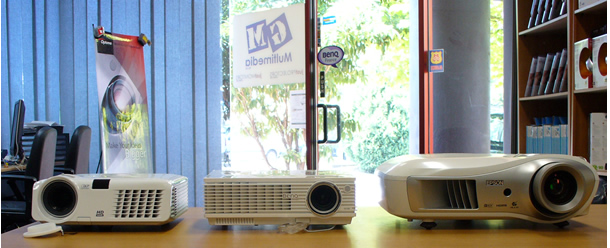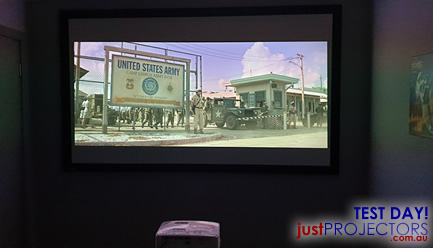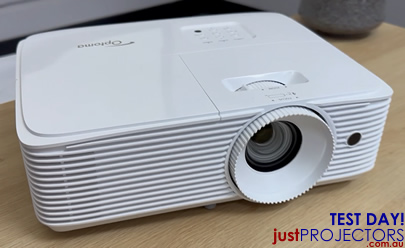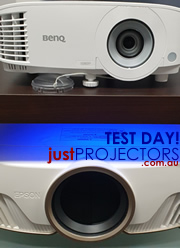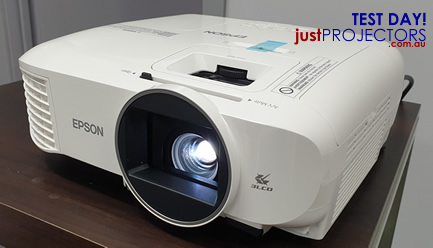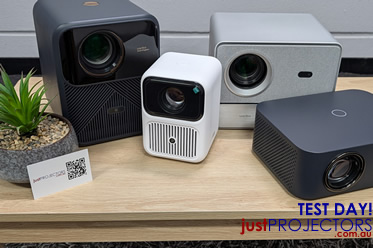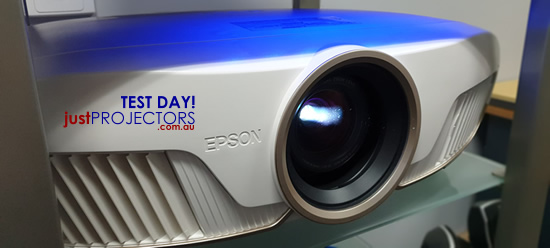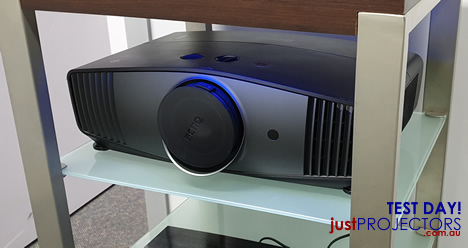Home Theatre Projectors
Choosing a Home Theatre Projector.
What resolution is best for home theatre?
What contrast ratio is best for home theatre?
Does a home theatre projector need to be installed?
What cables do home theatre projectors require?
How do I set up my Audio?
Is a LED, Laser, or a lamp projector best?
What is an Ultra Short Throw Projector?
What projectors do you recommend for home theatre?
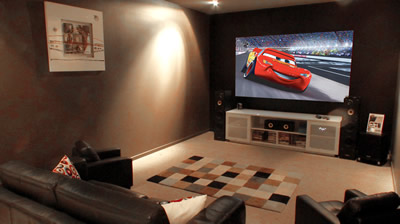
A brighter projector is not necessarily better, particularly for traditional home theatre use. Very bright projectors may not be able to produce the same level of colour reproduction or contrast levels. Bright projectors may also be louder due to the additional cooling requirements they have.
Brightness with most digital projectors is measured in ANSI Lumens or ISO Lumens. Both methods require the manufacturer to test their unit in regulated conditions to obtain a comparable rating. Be aware that some (particularly smaller brands advertised via online marketplaces) may not use a regulated brightness measurement. We have seen some projectors with an advertised ‘8000 lumen’ rating measure lower than 500 ANSI Lumens!
The best brightness level for your use will depend on the room conditions and the image size you wish to project.
- Under 2000 ANSI Lumens – This brightness level is common in the lifestyle entertainment projector range. These are great for dark rooms and smaller images sizes (usually up to 120” but make sure to check the specifications of the projector).
- 2000-3000 ANSI Lumens – Dark ‘theatre’ rooms. These projectors can offer amazing colour reproduction but need a darker room to get the best result.
- 3000-4000 ANSI Lumens – These are recommended if the room cannot be fully darkened. They are great for loungerooms or open plan areas, or even in traditional home theatre rooms if you want the flexibility to use the projector with some lights on nearby. Projectors in this brightness range are also popular for golf sim and gaming.

The resolution of a home theatre projector is the measurement of the number of pixels being projected and therefore the detail level that you will see. Resolution is represented by its name (ie FULL HD), or by the number of pixels wide vs high (ie 1920 x 1080). A higher resolution will provide a more detailed image. Some smaller (and often much cheaper) projector brands advertise their maximum resolution, rather than the real (native) resolution. The ‘Maximum Resolution’ specification represents the highest resolution of signal the projector can receive and has no bearing on picture quality, which is determined by the Native resolution specification.
The 2 best projector resolutions for home theatre are::
- Full HD 1920x1080 - This is the same resolution as a typical bluray disk and what many films are streamed in when viewing on streaming apps.
- 4K 3840x2160 - This 4K resolution equals 4 Full HD displays and therefore offers a significant increase in image detail. The 4K resolution is common on new gaming consoles, such as the Xbox Series X and PlayStation 5, and is also available on 4K Blu-ray disks and on some streaming apps. 4K Projectors can cost more than a Full HD projector however are worth considering to get the best detail possible.
- Also worth noting is the '4K Enhanced' resolution. You may see this 4Ke resoluiton mentioned on many Epson projectors. This resolution is still considered 4K and offers great detail, however due to the way the projector produces this resolution (by means of pixel shifting), the level of detail is slightly less than a true 4K projector.
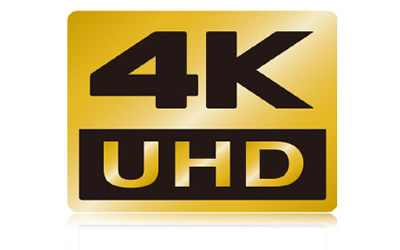
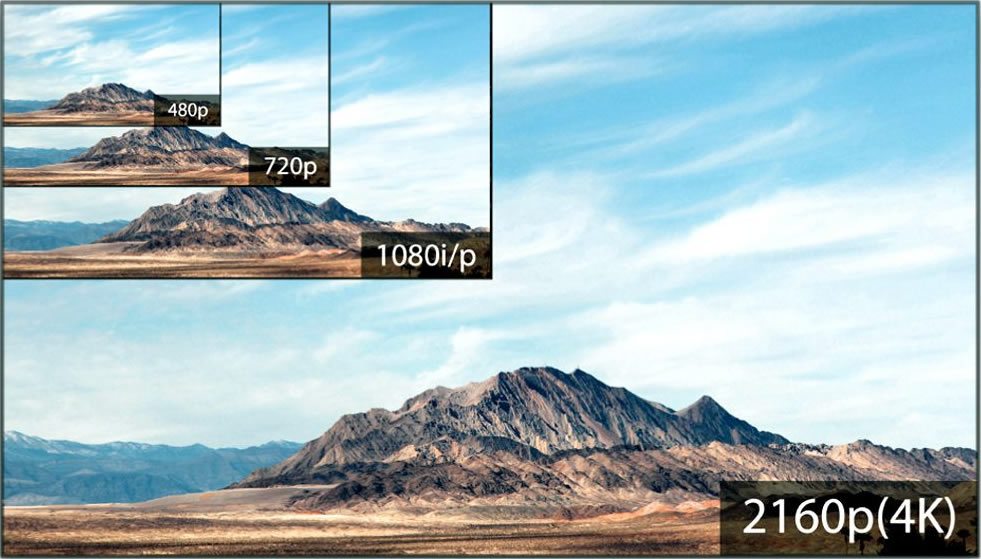
Contrast Ratio is another important specification of a home theatre projector. Contrast defines the difference between the whitest whites and the blackest blacks. If the peak white value is significantly different than the peak black value, the signal is said to have high contrast resulting in well defined & detailed shading. A contrast of 10,000:1 means that the blackest black on the image will be 10,000 times blacker than the whitest white.
For a dedicated home theatre projector, that will be used in a darkened room, a contrast ratio of 10,000:1 or more is best. In rooms that regularly have some ambient light, a high contrast projector is not required as ambient light in the room reduces any ill-effect that a low contrast rating may cause. If you plan to use your projector mainly in a lit or even semi-lit room, the contrast ratio is not of vital significance.
Unlike with ANSI Lumens, there is no standard method of measuring contrast. This means it can be difficult to compare models as different brands may use different methods that give higher figures. Laser projectors in particular tend to advertise contrast figures in the millions. Whilst laser projectors can offer better black levels the figure can sometimes be deceiving.
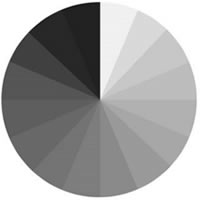

Professional projector installation is not always necessary but is usually the most common option for dedicated home theatre spaces. Having your home theatre projector installed in the ceiling allows for discrete ceiling-recessed cabling, consistent image quality without the need for regular adjustment, and keeps the projector and cables away from the viewer to avoid accidental knocks.
Ceiling installation is not for everyone as many users may wish to keep the projector portable or may have a landlord that is not overly keen on having a ceiling mount installed. There are also select projector models that cannot be installed, such as many UST projectors and select Lifestyle projectors.
If installing your projector, we recommend referring to your projectors advertised throw-ratio to calculate the required installation distance. The required installation distance varies between models, so may not be the same as an old projector you have used. Further information on calculating installation distance can be found on our blog.
Projectors usually would be placed in the centre of the image (horizontally), however there are times you need to place the projector off-centre (for example you need to have the projector to the side to avoid a ceiling fan like in the following image). In this case you will need to select a projector with horizontal lens shift (ideally) or horizontal keystone correction.
Putting your projector on a shelf is possible, but be aware that most aren't designed for this. When placed flat, projectors typically project upwards (away from the surface). This is the same principle behind upside-down ceiling mounting, which directs the image downwards. Consequently, placing a projector high on a shelf will likely cause the image to project upwards, requiring a lot of tilting to aim it down. If you plan to use a high shelf, prioritise projectors with significant lens shift or consider mounting the projector upside down beneath the shelf.
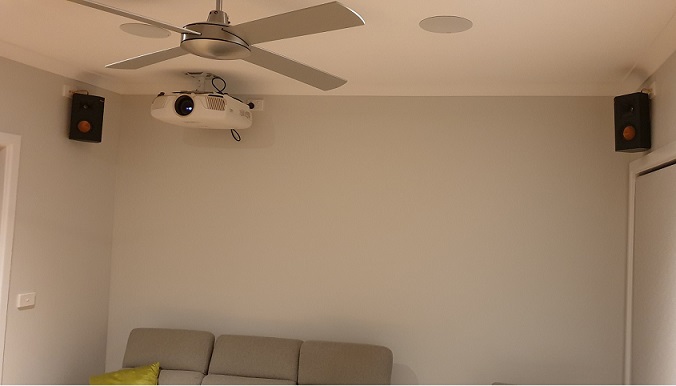
Traditionally projectors would feature AV connections such as VGA, Component, Composite, and S-video. These connections all use analogue signals and, by todays standards, provide a fairly low-quality picture.
HDMI is now the standard connection included with every mainstream projector model. HDMI (High Definition Multimedia Interface), uses high bandwidth digital signals that can provide a significant improvement in detail and colour reproduction over dated analogue connection types. Home theatre projectors should always be connected via a High-Speed grade HDMI cable. A good quality HDMI cable can usually transmit FULL HD signals up to approximately 20 metres. If you wish to send 4K signals, we recommend using an ACTIVE type of HDMI cable that boosts the signal to minimise the risk of signal drop-out. For long distances an OPTICAL ACTIVE cable is recommended.
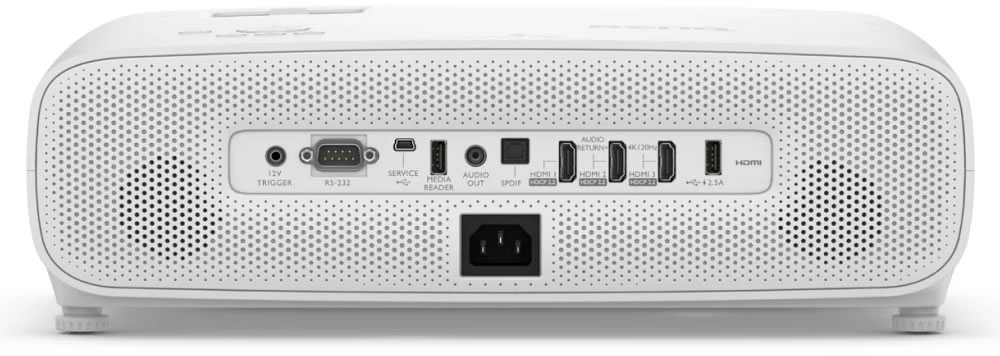
Whilst home theatre projectors are not foremost an audio device, many models will feature a small inbuilt speaker; this can be handy for movies on the go and for small rooms. As these speakers are normally only 3-10 watts in power (similar to a small TV) we recommend the use of a separate sound system for most customers.
A 5.1 or 7.1 home audio solution is best way to experience amazing surround sound at home. Just Projectors offers a range of bundles of Speakers and AV Receivers, or you can build your own. A good quality Receiver (also called an Amplifier) will let you connect multiple sources/players at once, decode your surround sound audio signals, send audio to the individual speakers, and connect the video up to the projector through a HDMI cable. This type of system does take more work to install but the audio quality is amazing. Please visit our speakers page to see our bundles.
Another option, that is far easier and cheaper to install, is a Sound Bar. You can view our range of projector compatible Sound Bars on our Sound Bars page. A Sound Bar can sit on a shelf or TV unit under your screen, or even mount to the wall. Basic sound bars can cost around $250-300 with higher quality options over the $1K mark. Projectors work a little differently to a TV, so when choosing a Sound Bar be sure to select one that features both a HDMI IN and a separate HDMI OUT port. As many projectors do not feature eARC it can be more difficult to pair them with sound bars that only use this connection.
Whilst rare, Bluetooth Audio is available on some projectors, mainly in the portable entertainment category. Bluetooth audio is also available on many players such as AppleTV, Google TV, and Amazon’s FireTVStick. Bear in mind that Bluetooth transmits slower than a cable and therefore is susceptible to audio lag.
Home Theatre projectors will feature an inbuilt light source that creates the light you see on screen. This light source traditionally has been a mercury lamp but more recently LED and Laser based light sources have become commonplace. Traditional projector lamps have a limited life and therefore are designed to be replaced. The lamp life on modern projectors tends to be very long so it is not unusual for a lamp to only need replacement every 2 or 3 years depending on the use.
Lamp-Free light sources such as LED and Laser are designed to last the life of the projector and are not designed to be replaced. This can make the projector cheaper to run long-term than a lamp-based projector, however they tend to have a higher upfront cost.
As a general rule a Laser-based projector will be brighter than an LED based model, however this can vary as technology develops so always check the projectors advertised ANSI or ISO Lumen brightness rating. Whilst a projector with one of these lamp-free technologies is cheaper to run it does not always mean the projector is better in every way; Features, Colour Reproduction, Brightness, Contrast, and Image Processing will vary between each home theatre projector. Lamp based projectors are still very common for home theatre use and, for many clients, could still be the best option.
Ultra Short Throw (UST) projectors are designed to project large images from very close range. Utilising specialised optics, some models can create displays exceeding 2.5 meters in width from a distance of under 40 centimetres. Often placed on a TV unit, UST projectors can help users avoid expensive installation costs. However, their steep projection angle necessitates careful setup and limits compatibility, typically requiring a fixed frame screen to prevent image distortion. Furthermore, many UST projectors have a narrower range of achievable image sizes, often capping out around 120 inches.
What projectors do you recommend for home theatre?
[top]It can sometimes be difficult to select the best home theatre projector sight unseen, which is why we throughly test new releases so we can offer the best possible advice and recommendations to our customers. The below list is updated regularly with projectors our experts believe are the best home theatre projectors available today. Our team are always happy to offer their advice and recommendation to suit your requirements, please contact us.
Home Theatre Recommendations
Wanbo DaVinci 1 Pro
1080p Full HD LED
Entertainment Projector

- Free Delivery!
- 600 ANSI Lumens
- 2.8kg Weight
- Android 11.0 Inbuilt
- Wireless Streaming
- Bluetooth Audio 5.0
- 2x 8W Speakers
Wanbo Mozart 1 Pro
2025 Edition 1080p LED
Entertainment Projector

- 1200 ANSI Lumens
- 90% DCI-P3 Colour
- Premium Bass Woofer
- 4K & HDR Compatible
- 4K App Support
- 3.3kg Weight
- Android 11.0 Inbuilt
- Wireless Streaming
- Bluetooth Audio 5.0
Optoma HD28e
1080p Full HD
Home Projector
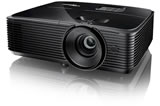
- 3800 ANSI Lumens
- 30,000:1 Contrast
- Best Under $1k!
Optoma HD30HDR
1080p Full HD
Home Projector

- 3800 ANSI Lumens
- 50,000:1 Contrast
- 4K & HDR Compatible
- Fast Gaming Modes
ViewSonic PX701-4K
2160p 4K
Home Projector

- 3200 ANSI Lumens
- 12,000:1 Contrast
- Fast Gaming Mode
Optoma HD39HDR
1080p Full HD
Home Projector

- 4500 ANSI Lumens
- 50,000:1 Contrast
- 4K & HDR Compatible
- Fast Gaming Modes
ViewSonic PX749-4K
2160p 4K
Home Projector

- 4000 ANSI Lumens
- 12,000:1 Contrast
- Fast Gaming Mode
- Xbox Certified
- Harman-tuned Speaker
Optoma UHD35+
2160p 4K
Home Projector

- 4000 ANSI Lumens
- 1,200,000:1 Contrast
- Fast Gaming Mode
Epson EH-TW6250
2160p 4Ke
Home Smart Projector

- 2800 ANSI Lumens
- Smart Apps Inbuilt
- Bluetooth (in app only)
- Lens Shift + Big Zoom
Epson EH-TW7100
2160p 4Ke
Home Projector

- 3000 ANSI Lumens
- 100,000:1 Contrast
- Low Fan Noise
- Lens Shift + Big Zoom
Optoma UHD55
2160p 4K
Home Projector

- 3600 ANSI Lumens
- 1,200,000:1 Contrast
- DCI-P3 Colour
- Fast Gaming Mode
- Smart USB Media Player
BenQ TK710
2160p 4K Laser
Home Projector

- 3200 ANSI Lumens
- 600,000:1 Contrast
- REC709 Colour
BenQ TK710STi
2160p 4K Laser
S/Throw Home Projector

- 3300 ANSI Lumens
- 600,000:1 Contrast
- REC709 Colour
- Smart Media Player
- Short Throw
Optoma Wave 130RK
2160p 4K Laser
Home Projector

- 4000 ANSI Lumens
- 2,300,000:1 Contrast
- 98% REC.709 Colour
- Fast Gaming Mode
BenQ X3100i
2160p 4K LED
Home Projector
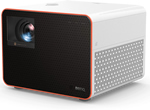
- 3300 ANSI Lumens
- 600,000:1 Contrast
- 100% DCI-P3 Colour
- Fast Gaming Mode
- Android 11 Inbuilt
BenQ W2720i
2160p 4K LED
Cinema Projector

- 2500 ANSI Lumens
- 2,000,000:1 Contrast
- 98% REC.709 Colour
- Fast Gaming Mode
- Android 11 Inbuilt
ViewSonic V57-4K
2160p 4K RBG Laser
Home Projector
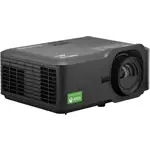
- 5200 RGB Laser Lumens
- 3,000,000:1 Contrast
- Triple Laser
- 100% BT.2020 Colour
- 2025 Projector of the Year
ULTRA SHORT-THROW LASER PROJECTOR RECOMMENDATIONS
Epson EH-LS650B
2160p 4K Laser
UST Home Projector

- 3600 ANSI Lumens
- 2,500,000:1 Contrast
- Ultra Short Throw
- Android TV Inbuilt
Epson EH-LS800B
2160p 4K Laser
UST Home Projector

- 4000 ANSI Lumens
- 2,500,000:1 Contrast
- Ultra Short Throw
- Android TV Inbuilt
Always Testing to get you the right advice
